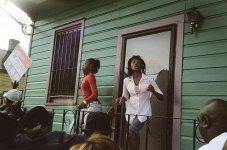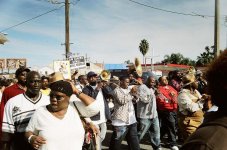R
ruben
Guest
I have no idea whom this question may concern. But it certainly concerns me.
If to judge upon several threads we have been having along time and recently, about how to do this or that, most owners seem to regard their Kontax as a "take your time" camera.
I think the "take your time" approach is quite controversial. During my times of freelancing, at my local areas of conflict, I have been very close to the most sofisticated professionals, also in terms of gear. I have seen some of them metering with hand held meters amidst clouds of gas, flying people and dust, although bearing the most modern cameras. I have seem some of them with manual Leicas too. Cappa took the Contaxes to WWII.
Therefore let me lead a "counter-attack" : what has made the Kontax, a "take your time" camera in our minds ?
In my opinion this is due to two factors: first it is our gear mind guilt only. In spite of everything else, the lack of automation twists our elevated minds like in the most beginner of beginners.
The second factor is more related to the outside world. We have lost live contact with oldtimer Kontax users enabling us to know how to make the most of these breeds, under conditions of war, or stress, or peacefull but fast street photography.
Not everything in street photography is fast shooting, and who else than we ourselves know it best. But a lot of it, it is.
Hence the need to know how to focus a Kontax held in vertical position, or how to minimize the use of hand held meters when time is short. Or the need of obtaining a white dome average exposure, less than perfect.
Cheers,
Ruben
If to judge upon several threads we have been having along time and recently, about how to do this or that, most owners seem to regard their Kontax as a "take your time" camera.
I think the "take your time" approach is quite controversial. During my times of freelancing, at my local areas of conflict, I have been very close to the most sofisticated professionals, also in terms of gear. I have seen some of them metering with hand held meters amidst clouds of gas, flying people and dust, although bearing the most modern cameras. I have seem some of them with manual Leicas too. Cappa took the Contaxes to WWII.
Therefore let me lead a "counter-attack" : what has made the Kontax, a "take your time" camera in our minds ?
In my opinion this is due to two factors: first it is our gear mind guilt only. In spite of everything else, the lack of automation twists our elevated minds like in the most beginner of beginners.
The second factor is more related to the outside world. We have lost live contact with oldtimer Kontax users enabling us to know how to make the most of these breeds, under conditions of war, or stress, or peacefull but fast street photography.
Not everything in street photography is fast shooting, and who else than we ourselves know it best. But a lot of it, it is.
Hence the need to know how to focus a Kontax held in vertical position, or how to minimize the use of hand held meters when time is short. Or the need of obtaining a white dome average exposure, less than perfect.
Cheers,
Ruben



